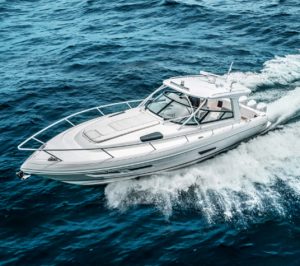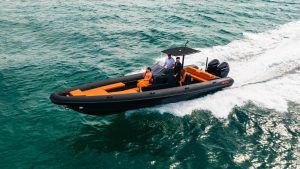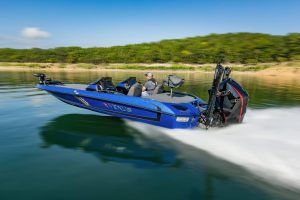Flats Boats For Sale: Buyers Guide
Flats boats, also known as flats skiffs, are a distinct breed of fishing vessels designed for navigating shallow waters typically found in southern waterways, mainly in Florida. These lightweight boats are purposefully engineered to minimize draft so they can run in shallow water while providing great casting decks for anglers.
One of the main attractions of flats boats is their ability to glide through waters as shallow as just 5 inches deep, making them an excellent option for fishing in very shallow waters. These boats are crafted to provide durability and can usually accommodate up to four passengers, with an average length ranging between 15 and 25 feet.
In this ultimate guide to flats boats, we will explore the various features and aspects that make these fishing machines a top choice for shallow water fishing enthusiasts. From their unique design and capabilities to the top models available in the market, this guide aims to equip readers with valuable insights to make informed decisions when considering owning or operating a flats boat.
Types of Flats Boats
Flats boats are popular for their shallow draft and ability to navigate through shallow waters. They come in various types, catering to different needs and preferences of anglers. This section will discuss two main types of flats boats: Technical Polling Skiffs and Bay Boats.
Technical Polling Skiffs
Technical Polling Skiffs are designed for extreme shallow water fishing, typically in water as shallow as 5 inches deep. These boats are lightweight and have a flat bottomed hull, which allows them to glide effortlessly through the shallow waters. They are typically 15 to 25 feet in length, with a maximum passenger capacity of four people. Some popular brands for technical polling skiffs include Hewes, Maverick, and Hell's Bay.
These boats often come with features such as:
- Poling platforms for increased visibility and casting position
- Shallow water anchors for precise positioning
- High-quality trolling motors for stealthy approaches
Bay Boats
Bay Boats, though similar to flats boats, are crafted for fishing in slightly deeper waters while still maintaining a shallow draft for navigating shallow bays and estuaries. Their size ranges from 20 to 24 feet, making them slightly larger than technical polling skiffs. This increased size allows for a smoother ride in choppy conditions and provides additional space for storage and passengers.
Features commonly found in bay boats include:
- Trolling motors for steady, controlled navigation
- Various live wells and fish boxes for storing bait and catches
- Rod holders and tackle storage for organization and convenience
Both Technical Polling Skiffs and Bay Boats provide anglers with unique benefits depending on their specific fishing needs. While Technical Polling Skiffs excel in shallow water conditions, Bay Boats offer more versatility in slightly deeper waters with added amenities for a comfortable fishing experience.
Essential Features
Hull Design
The hull design of a flats boat is crucial for its performance and ability to navigate shallow waters. Flats boats usually have a shallow, flat-bottomed hull, which allows them to float in very shallow water, providing excellent stability while fishing. Fiberglass construction is common for these boats, offering both durability and lightweight design. In addition to the flat bottom, a tunnel hull design can significantly improve the ability to navigate shallow waters by channeling water through the center of the boat, reducing the draft.(source)
Draft
One of the most important features of a flats boat is its shallow draft. A shallow draft enables the boat to float and operate in very shallow water, allowing anglers to access prime fishing spots in shallow coastal areas. Most flats boats can float in water as shallow as 12 inches, with some models specifically designed to operate in water depths as low as 8-10 inches(source).
Weight
Lightweight construction is another critical feature of flats boats, as it helps reduce the overall draft of the boat and allows for easier transportation. The use of fiberglass and other lightweight materials in hull construction ensures flats boats maintain stability and performance while remaining relatively lightweight. Weight management also contributes to fuel efficiency, as a lighter boat requires less power to propel and maintain speed.
Storage
Storage is an essential feature for any fishing boat, including flats boats. A well-designed flats boat should include ample storage compartments for fishing gear, personal items, and any catch from a successful fishing trip. Storage spaces should be easily accessible, dry, and secure to keep equipment in good condition and prevent accidental loss. Examples of storage solutions include under-seat compartments, built-in coolers, and rod storage systems.
Pole Holders
Pole holders are a crucial aspect of convenient flats fishing. Sturdy and easily accessible pole holders allow anglers to secure their fishing poles while focusing on casting or adjusting their position within the boat. Some flats boats even come equipped with specialized pole holders for shallow water poling, an essential technique for navigating extremely shallow waters and getting closer to fish without startling them(source).
Motor and Propeller Selection
Choosing the right motor and propeller for your flats boat is crucial for ensuring optimal performance and maneuverability. The selection process involves considering various factors, such as boat size, weight, and intended use. Let's take a look at some of the key components to consider when selecting motors and propellers for your flats boat.
Outboard Motors
Outboard motors are a popular choice for flats boats due to their efficiency, power, and ease of maintenance. When selecting an outboard motor, it's essential to consider the horsepower (HP) required for your boat's size and weight. Typically, flats boats range from 15 to 22 feet and require a motor between 40 and 150 HP. Consult your boat's manufacturer for specific recommendations on engine size and HP.
Additionally, four-stroke outboard motors are generally preferred due to their fuel efficiency, quieter operation, and lower emissions. However, two-stroke outboard motors can still be a viable option for those seeking a lightweight motor with a faster acceleration rate. Some popular outboard motor brands include Honda, Yamaha, and Mercury.
Shallow Water Anchors
Shallow water anchors provide additional stability and control when fishing in shallow waters. These devices allow you to keep your boat stationary without the need for a traditional anchor. This is particularly useful in areas with soft or unstable bottom conditions where a conventional anchor might struggle to hold.
There are several types of shallow water anchors, including manual, mechanical, and electronic systems. Manual shallow water anchors, such as push poles, require physical force to deploy, while mechanical and electronic systems can be operated with the push of a button. Some popular shallow water anchor systems include Power-Pole and Minn Kota Talon.
Propeller Selection
Choosing the right propeller for your flats boat is essential for optimal performance and fuel efficiency. Boat propeller selection depends on factors such as boat size, weight, and engine horsepower. A helpful tool for selecting the right boat propeller is provided by Propeller Depot.
Key considerations when selecting a boat propeller include material, blade count, and pitch. Stainless steel propellers typically offer increased performance and durability compared to aluminum materials (LUND). Additionally, the number of blades and their pitch can significantly impact boat speed, acceleration, and handling. Consult a marine professional or refer to your engine manufacturer's recommendations for specific guidance on propeller size and type.
Accessories and Upgrades
When it comes to enhancing your flats boat experience, there are various accessories and upgrades available on the market. In this section, we will discuss electronics, power poles, and trolling motors as significant components for customizing your flats boat.
Electronics
Modern electronics play a crucial role in improving your flats boat's functionality and overall fishing experience. Some of the essential electronics to consider for your flats boat include:
- GPS and fish finders: These devices aid navigation and help you locate fish more effectively. There are various models available that cater to different budgets and preferences.
- Marine radios: A marine VHF radio is essential for communication and safety on the water. Make sure to invest in a quality radio with a waterproof housing for durability.
- Battery chargers: Having an onboard battery charger ensures your electronic devices stay powered throughout your fishing trips. Consider choosing a charger with multiple outputs for added convenience.
Power Pole
A power pole is an excellent addition to any flats boat. This shallow water anchoring system quickly and quietly secures your boat in shallow water, allowing you to focus on fishing. Power poles come in various sizes and models, so selecting one that fits your boat and meets your needs is essential. Some features to look for include:
- Weight and height compatibility with your boat
- Easy installation and operation
- Durability and corrosion resistance
- Remote control options for added convenience
Trolling Motor
A trolling motor significantly improves your flats boat's maneuverability in shallow waters. These motors are available in several types, including bow-mounted, transom-mounted, and engine-mounted. Factors to consider when selecting a trolling motor include:
- Thrust: Ensure the trolling motor has ample thrust to move your boat efficiently. A general rule of thumb is to allocate 2 pounds of thrust per 100 pounds of boat weight.
- Voltage: Trolling motors come in 12V, 24V, and 36V options. Select a voltage based on your boat's battery system and your expected usage.
- Shaft length: Choosing the correct shaft length is crucial for optimum performance. Measure the distance from the mounting location to the waterline and choose a motor with a suitable shaft.
- Control options: Trolling motors offer various control options, such as hand-controlled, foot-controlled, or remote-controlled models. Consider your preferences and the space available on your boat when selecting a control method.
Equipping your flats boat with the right electronics, power pole, and trolling motor enhances your fishing experience and helps ensure a successful day on the water.
Flats Fishing Tips
Flats fishing offers both excitement and challenges for anglers. Here are some essential tips for successful fishing in these shallow waters.
Sight Fishing
Sight fishing is a high-precision technique often used in flats fishing, which involves spotting fish directly and casting your lure near them (FishingBooker). Anglers should pay attention to water clarity and light conditions, as they can impact visibility. Polarized sunglasses may help in cutting down glare and aiding in spotting fish underwater. Practicing accurate and stealthy casting is crucial, as a wrong move can scare the fish away.
Stealth
Stealth plays a crucial role when fishing on the flats. In shallow waters, fish can be more sensitive to noise and movement. When approaching a potential fishing spot, slow down your boat, and keep noise levels to a minimum. Use a push pole or an electric trolling motor to navigate quietly. Furthermore, make slow and deliberate movements when casting your line, as sudden actions may spook the fish.
Tides
Tides have a significant effect on flats fishing, and understanding them can lead to a more productive fishing experience (boats.com). Fish often move into shallow waters during incoming tides to feed and retreat to deeper waters during outgoing tides. Anglers should time their fishing trips to coincide with these tidal movements for the best results. Additionally, pay attention to the tide levels when navigating your boat through shallow areas, as low tide can expose hidden obstacles and potentially damage your boat.
Maintenance and Care
General Cleaning
To keep your flats boat in top condition, regular cleaning is essential. A well-maintained boat not only performs better but also lasts longer. To prevent the fiberglass gel coat from oxidizing and turning chalky, make sure to wash and wax the boat regularly. According to the Sea Ray, it is recommended to use mild soaps and soft-bristle brushes for most cleaning jobs. For boats used in saltwater, rinsing off with a garden hose is essential to prevent corrosion. Avoid using high-pressure washers, as they can damage the boat.
Engine Care
Regular engine maintenance is critical for the smooth operation and longevity of your flats boat. The first step in boat motor maintenance is checking the oil. According to Quicknav, you can do this by removing the cowl from the engine to expose the dipstick, often with a bright yellow handle. Remove the dipstick, wipe it clean with a rag or towel, and reinsert it into the tube. This will give you an accurate reading of the oil level.
Ensuring adequate lubrication of all moving parts is another crucial aspect of engine care. Frequently inspect and maintain the throttle and shift cables, steering system, and propeller shaft. Lubricate these components as needed to prevent premature wear and ensure smooth operation.
Finally, monitor the fuel system regularly for any signs of leaks, cracks, or damage. Replace fuel filters and inspect hoses as needed to maintain optimal fuel flow and engine performance.










